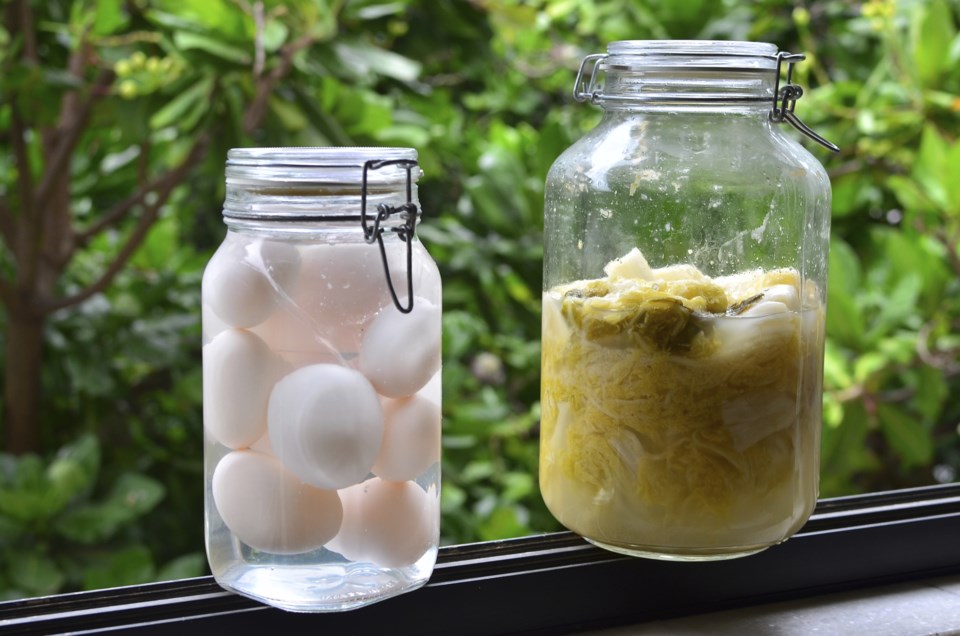Fermentation is the process in which opportunistic bacteria break down carbohydrates and proteins into carbon dioxide. This process not only makes food more nutritious, but more delicious as a result. Fermentation cannot proceed without the aid of external yeasts and bacteria proving that not every microorganism plays the role of villain.
Fermented foods and beverages can be found in every culture as a means of preservation before we consciously learned the many health benefits they provide.
Benefits of fermented foods
Preserves food This a great alternative to canning, because you are getting all sorts of beneficial gut bacteria.
Makes food more nutritious Along with probiotics, fermenting your foods also creates B- vitamins and Omega-3 fatty acids, it also increases enzyme and vitamins already in foods.
Protects against disease Ninety per cent of our immune system is in our gut, so generally speaking, when we heal our digestive system, we are healing ourselves all around.
Removes toxins from foods and body Fermented foods are great chelators, meaning they draw out and remove heavy metals and other toxins from the body.
Good source of probiotics Introducing beneficial bacteria to your gut will help balance out bacteria in your digestive system, improving immunity, digestion, and overall well being.
Cost effective Fermented foods are so rich in nutrients and many strands of beneficial bacteria that you won't have to buy any more probiotic supplements.
Great for digestion Digestion is important because it breaks food down into nutrients to be absorbed by the bloodstream and carried to cells throughout the body. Good digestion contributes to an overall feeling of well-being.
Zombie Apocalypse When the zombies come, fermentation will be a great way to preserve food and get some nutrients for your malnourished body. That hit of sauerkraut could mean the difference between surviving long enough to get to a safe house (in Vancouver I would probably try a roof) and getting mauled by a group of zombies at Cambie Station because you didn't have the energy to run up the hill. Think ahead and start experimenting in your kitchens today!
Different types of Fermentation
Lacto-fermented
Starches and sugar in fruits and veggies are converted into lactic acid. There are natural good bacteria that live on the surface of plants that are beneficial but need that extra help to be brought out. This is where a culture can come in handy. A well known example of this is yogurt; a culture of Lactobacillus bacteria is added to heated milk and converts the lactose (milk sugar) into lactic acid, thickening the milk and giving it the familiar characteristic of yogurt.
Wild fermentation
This process works by letting all the bacteria and yeast from the air inhibit the host, a great example would be sauerkraut where salt draws water from the cabbage creating a brine that attracts the growth of good bacteria.
Different types of fermented foods
Sauerkraut, kimchi, yogurt, kvass, kombucha, kefir, sourdough bread, miso, tempeh.
*Most store bought ferments are pasteurized, killing off the beneficial bacteria we have come to know and love. Be sure to read labels and look for words like unpasteurized and raw.
RECIPE: Fermented String Beans
Pickling without canning: Perfect for caesars!
Ingredients:
Enough String Beans to fill a medium size mason jar
1 Bay leaf
3-4 Whole garlic
chili flakes for added heat if desired
Brine – 2 Tbs Sea salt (not table salt!) to 1 quart of tap or filtered water
Elastic
Cheese cloth
Med size mason jar with lid
Instructions:
1. Make the brine by mixing 2 tbs of sea salt with 1 quart (4 cups) of water. Dissolve by stirring vigorously. You will have some brine left over if you want to make more than one jar of beans, if not just reduce the above ration accordingly.
2. Wash beans well and stuff inside the mason jar along with garlic, bay leaf and spices like chili flakes if desired. If you like it spicy add some chopped jalapeno peppers.
3. Pour brine over beans in mason jar, the beans and other contents must be completely submerged in the water. Make sure that there is nothing is sticking out of the brine to avoid mold.
4. Cover mason jar with cheese cloth and secure with elastic band. Leave on your counter for 3-5 days checking daily and scooping out any white foam appears on top(don't worry, it's just yeast!)
5. After 3-5 days take off the any residual foam, taste them, and if they are to your liking then cover jar with a lid and refrigerate. You can save your cheesecloth for your next ferments!



